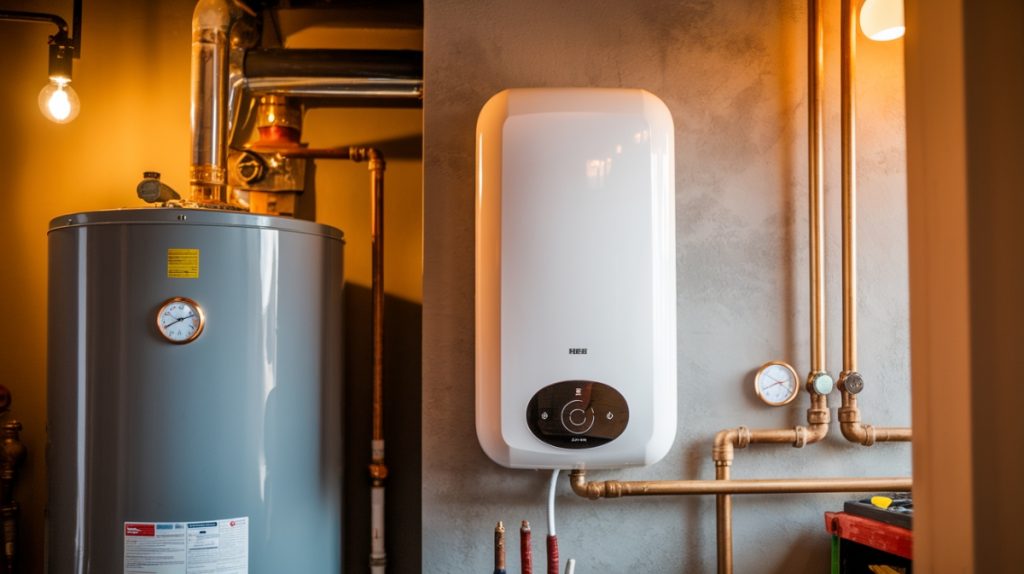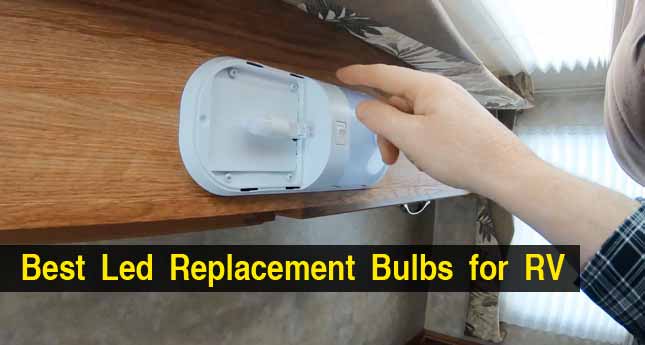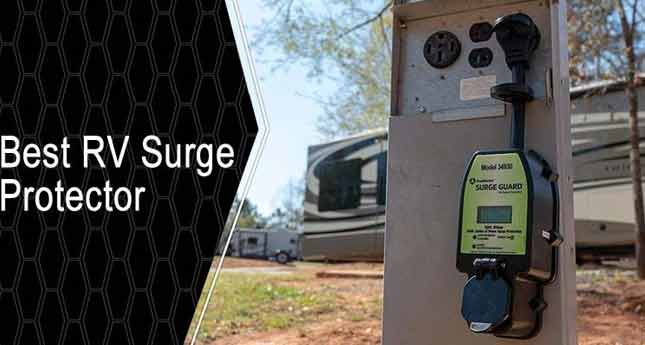Last Updated on October 21, 2024
When choosing between a tankless water heater and a standard storage tank, consider efficiency and cost. Tankless systems provide endless hot water, occupy less space, and can save you over $100 annually in energy costs. Their lifespan exceeds 20 years, but installation can be complex and costly.
Standard tanks hold 30 to 60 gallons, have a shorter lifespan of 10 to 15 years, and incur standby heat loss, leading to higher operating costs. Ultimately, the decision affects your utility bills and space requirements. Explore the key factors further to make the best choice for your home.
Key Takeaways
- Tankless water heaters provide continuous hot water, while storage tank heaters have a limited supply based on their capacity.
- Tankless units are more energy-efficient, saving up to 30% on energy bills compared to traditional storage tanks.
- Installation of tankless heaters is more complex and costly due to retrofitting requirements and potential plumbing modifications.
- While tankless heaters have a longer lifespan of over 20 years, storage tanks typically last 10 to 15 years.
- Annual maintenance for tankless heaters is recommended but generally involves fewer long-term issues compared to standard storage tanks.
Detailed Description of Water Heater Types
When it comes to choosing a water heater, you’ll typically encounter two main types: tankless and storage tank water heaters.
Tankless water heaters, also known as on-demand water heaters, heat water only when you need it, providing a continuous supply without the need for a storage tank. This results in significant energy savings, with homeowners saving at least $100 annually on utility bills compared to storage tank models.
In contrast, storage tank water heaters hold between 30 to 60 gallons of pre-heated water, which leads to standby heat loss and higher operating costs. These systems are common in U.S. homes but can be less energy efficient due to their constant heating requirement to maintain hot water.
Tankless systems are compact, making them ideal for homes with limited space, while storage tanks require more room. Lifespan is another factor: tankless models typically last over 20 years, compared to 10 to 15 years for storage tank heaters.
However, keep in mind that tankless units may involve higher installation costs due to potential plumbing retrofits and power upgrades, whereas storage tank heaters are generally simpler to install.
Cost and Installation Comparison
When comparing the costs of tankless and standard water heaters, you’ll notice that the initial purchase price for tankless units typically ranges from $525 to $1,150, while standard heaters are often priced between $570 and $600.
Installation costs also vary, with tankless systems requiring more specialized work, potentially raising your expenses to around $1,500.
Purchase Price Comparison
In today’s market, the purchase price comparison between tankless and standard water heaters reveals significant differences. Storage tank water heaters generally have a lower purchase price, costing between $570 and $600. In contrast, tankless water heaters range from $525 to $1,150, making tank models more affordable upfront.
While the upfront cost may entice you to choose a storage tank model, consider the installation costs as well. Installation for storage tank heaters typically ranges from $600 to $800, while tankless systems incur higher costs, from $800 to $1,500, due to specific venting and power requirements.
Although the average installation cost for both systems can equal around $1,500, shifting to a tankless system may require plumbing retrofits and service upgrades, further increasing your investment.
Despite the higher initial purchase and installation costs of tankless water heaters, they offer long-term savings on utility bills. Their energy-efficient design results in lower heating water costs over time, making them a financially savvy choice in the long run.
Installation Cost Factors
Understanding the differences in installation costs between tankless and standard water heaters is essential for making an informed choice. When considering tankless water heaters, you’ll notice that installation costs typically range from $800 to $1,500, whereas traditional storage tank heaters generally cost between $600 and $800 for installation.
Several factors contribute to the overall installation costs:
- Plumbing retrofits and service upgrades: Shifting to a tankless system may require modifications, adding to your expenses.
- Venting requirements: Tankless units often necessitate specific venting, which can complicate the installation.
- Labor costs: The complexity of tankless installations usually means higher labor costs compared to standard tank installations.
The average installation cost for gas tankless water heaters is about $1,250, while electric tankless systems can reach around $1,500.
Retrofitting Requirements Explained
Retrofitting your home for a tankless water heater can present significant challenges and costs, especially compared to standard storage tank installations. The complexity of retrofitting often stems from the need for plumbing modifications and other upgrades.
| Aspect | Tankless Water Heater |
|---|---|
| Installation Costs | $800 – $1,500 |
| Standard Storage Tank | $600 – $800 |
| Plumbing Modifications | Often required |
| Electrical Upgrades | May be needed for electric models |
Homeowners may encounter additional expenses due to necessary upgrades for gas lines or electrical panels, which are typically less common with standard installations. Tankless water heaters often require specific venting requirements, further adding to installation costs and complexity.
In contrast, standard storage tanks usually operate within existing setups, making them simpler to install. Understanding these retrofitting requirements will help you make an informed decision. Weighing the costs and the complexity of installation against the benefits of instant hot water is essential for your long-term satisfaction with your choice.
Energy Efficiency and Savings
How much can you really save by switching to a tankless water heater? The answer lies in the impressive energy efficiency these systems provide. By eliminating standby heat loss, tankless water heaters can save you up to 30% on energy bills compared to traditional storage tank models.
Consider the following points when evaluating savings:
- Lifespan: Tankless systems last over 20 years, while traditional models typically last 10-15 years.
- Initial Cost vs. Long-Term Savings: Although the upfront cost is higher for tankless heaters, their longevity and efficiency can lead to substantial long-term savings.
- Performance Ratings: Gas models of tankless water heaters are rated “Excellent” for energy cost efficiency, making them a smarter choice.
Transitioning to a tankless system might provide a payback period of 12 to 27.5 years, depending on the fuel type. While the initial investment is significant, the long-term savings and reduced operating costs make tankless water heaters a compelling option for energy-conscious consumers.
Performance and Reliability
While many homeowners appreciate the convenience of a continuous hot water supply, tankless water heaters deliver this benefit without the limitations of traditional storage tanks. Unlike standard storage tank heaters that can run out of hot water, tankless systems heat water on demand, ensuring you never face a cold shower unexpectedly.
In terms of reliability, tankless water heaters typically maintain a consistent output temperature, particularly gas models, which excel at reaching and sustaining desired temperatures. Electric versions can struggle at lower temperatures, but overall, tankless units outperform their tank counterparts.
With an average lifespan exceeding 20 years, tankless systems considerably outlast standard storage tanks, which usually last only 10 to 15 years. This longevity can translate into fewer replacements and ultimately lower overall costs.
However, keep in mind that the installation of tankless systems may require plumbing upgrades and more complex electrical work, which can introduce initial reliability concerns.
Yet, this upfront investment often leads to fewer long-term maintenance issues compared to traditional models, thanks to their energy efficiency and reduced waste by heating water only when necessary.
Maintenance Requirements
Maintaining a tankless water heater is vital for guaranteeing its efficiency and longevity. Unlike standard storage tanks that require periodic maintenance, tankless water heaters typically need annual maintenance. This includes flushing the system to remove mineral buildup, especially if you live in a hard water area. Proper maintenance not only enhances efficiency but also extends the lifespan of your unit.
When servicing your tankless water heater, keep these key tasks in mind:
- Flushing the system: This removes mineral deposits that can impede performance.
- Checking for sediment buildup: Regular checks can prevent costly repairs down the line.
- Inspecting components: Look for signs of wear or damage to guarantee peak operation.
Neglecting maintenance can lead to decreased efficiency, resulting in higher operating costs. While tankless units are generally more forgiving with maintenance frequency than standard storage tanks, regular check-ups are still important.
Choosing the Right Option
When you’re choosing between a tankless water heater and a standard model, consider the initial cost, energy efficiency, and installation complexity. Tankless systems often have higher upfront expenses but can save you money on energy bills over time.
Initial Cost Comparison
Choosing the right water heater involves a careful comparison of initial costs, which can greatly impact your budget. When deciding between tankless water heaters and storage tank water heaters, you’ll notice the purchase price and installation costs play a significant role.
Here’s a quick breakdown of initial costs:
- Purchase Price: Storage tank models range from $300 to $2,000, while tankless units typically cost between $525 and $3,000.
- Installation Costs: Expect to pay around $600 to $800 for storage tanks, but for tankless systems, costs can go up to $1,500 due to additional requirements.
- Total Initial Investment: A gas tankless water heater can reach up to $2,650, compared to about $1,500 for a conventional model.
While tankless water heaters come with higher upfront costs, they offer long-term financial benefits by saving homeowners at least $100 annually on utility bills. Additionally, if you’re shifting from a storage tank, consider potential retrofitting and changeover costs that could complicate your initial investment.
Energy Efficiency Analysis
Evaluating energy efficiency is essential when deciding between tankless and storage tank water heaters. Tankless water heaters can be 8 to 34% more energy-efficient than traditional storage tank models, thanks to their on-demand heating capability. This design prevents standby energy losses, which occur when water is continuously heated in a tank.
When looking at operating costs, gas tankless heaters have an annual operating cost of about $195, compared to $245 for gas storage heaters. Electric tankless models fare slightly better as well, with costs around $535 versus $580 for electric storage heaters. The energy savings can greatly impact your budget over time.
Moreover, tankless water heaters typically last over 20 years, enhancing energy efficiency by reducing replacement frequency. In contrast, most storage tank heaters last only 10 to 15 years. While shifting to a tankless system might involve higher installation costs—averaging between $800 to $1,500—these upfront expenses can be offset by long-term savings on energy bills and lower annual operating costs.
Installation Complexity Factors
While considering energy efficiency is important, the installation complexity of tankless water heaters versus standard storage tank models also plays a significant role in your decision-making process. The installation costs for tankless systems typically range from $800 to $1,500, compared to $600 to $800 for standard storage tank heaters.
This reflects the complexity of venting and power requirements for tankless systems. You may face several challenges during the installation process, including:
- Plumbing retrofits to accommodate the new system
- Electrical upgrades, which may be necessary to support higher power demands
- Gas line modifications if you opt for a gas tankless heater
Additionally, the average installation time for tankless water heaters is often longer due to their intricate setup. Proper sizing is essential; incorrect sizing can lead to performance issues, rendering the system ineffective.
Frequently Asked Questions
Is a Tankless Water Heater Better Than a Regular Water Heater?
You might think a tankless water heater isn’t worth it due to higher initial costs but consider the long-term savings. With energy efficiency ranging from 8 to 34%, you could save considerably on utility bills. Plus, their lifespan exceeds 20 years, reducing replacement costs. While they may struggle to supply multiple outlets, proper sizing can mitigate this issue.
What Is the Downside of a Tankless Water Heater?
A tankless water heater has several downsides. You’ll face higher upfront costs and potential installation challenges, especially if your plumbing or electrical systems need retrofitting. These units can struggle to provide hot water to multiple outlets simultaneously, limiting their flow rate to 2 to 5 gallons per minute. Additionally, maintenance can be more frequent in hard water areas, and the payback period can range from 12 to 27.5 years, making it a lengthy investment.
Is It Worth Switching to a Tankless Water Heater?
Switching to a tankless water heater can feel like stepping into a world of endless hot water. You’ll enjoy savings on utility bills, and with a lifespan of over 20 years, it’s a long-term investment in comfort. While the initial cost might seem intimidating, tax credits can help ease the financial burden. This upgrade could enhance your home’s efficiency and convenience if you have high hot water demands.
Can I Replace My 40 Gallon Water Heater With a Tankless Water Heater?
Yes, you can replace your 40-gallon water heater with a tankless system. However, you must assess your household’s hot water demand to guarantee the tankless unit can handle peak usage. Since tankless heaters provide hot water on demand, proper sizing is essential. Be prepared for potential plumbing and electrical upgrades during installation. While the initial cost is higher, you’ll benefit from energy savings and a longer lifespan than traditional units.
Energy Efficiency Meets Comfort: Tankless Could Be Your Perfect Match
In the great showdown of tankless versus standard water heaters, it’s clear you’re not just picking a unit; you’re choosing your water-warming destiny. If you enjoy endless hot showers and lower energy bills, the tankless champ might be your dream.
But if you prefer a bulky tank that promises to keep you on your toes with an unpredictable hot water supply, then by all means, stick with the standard. After all, who doesn’t love a little suspense in their daily routine?



